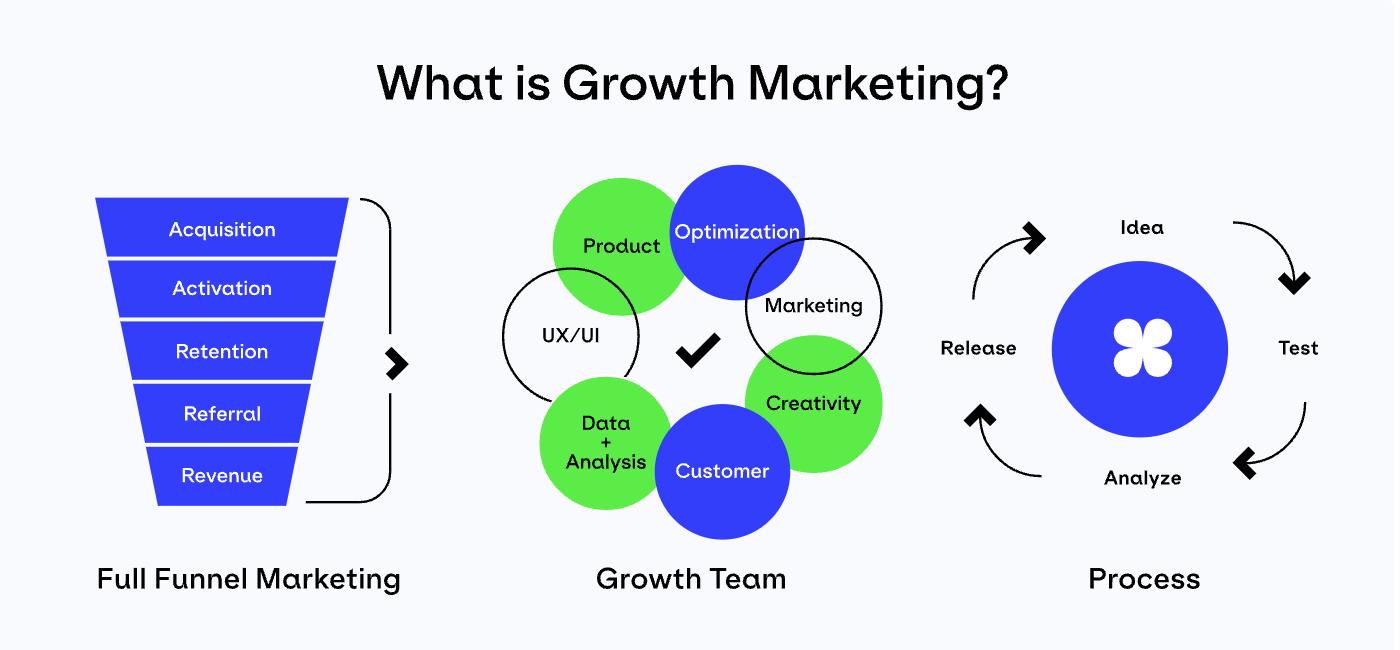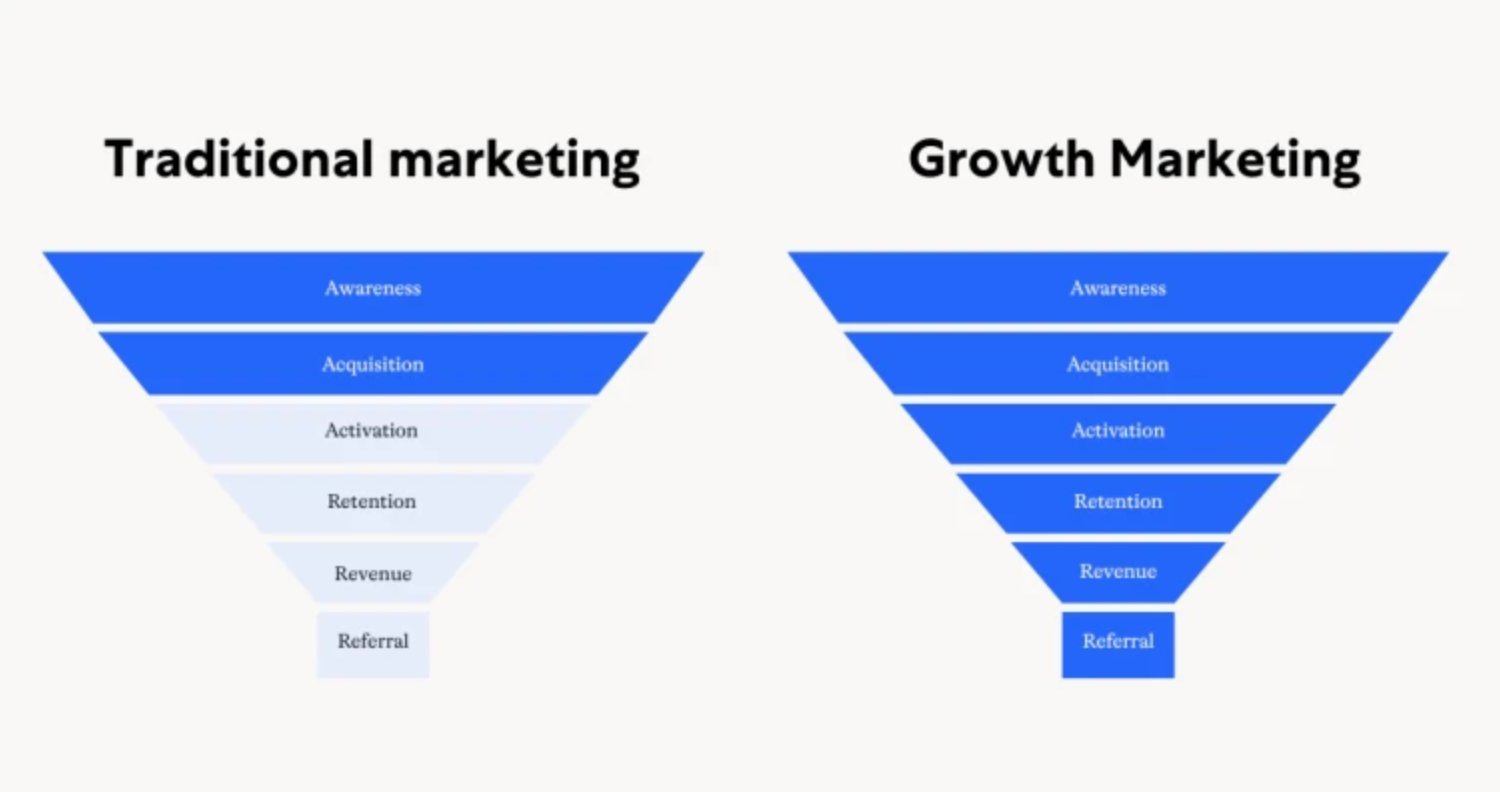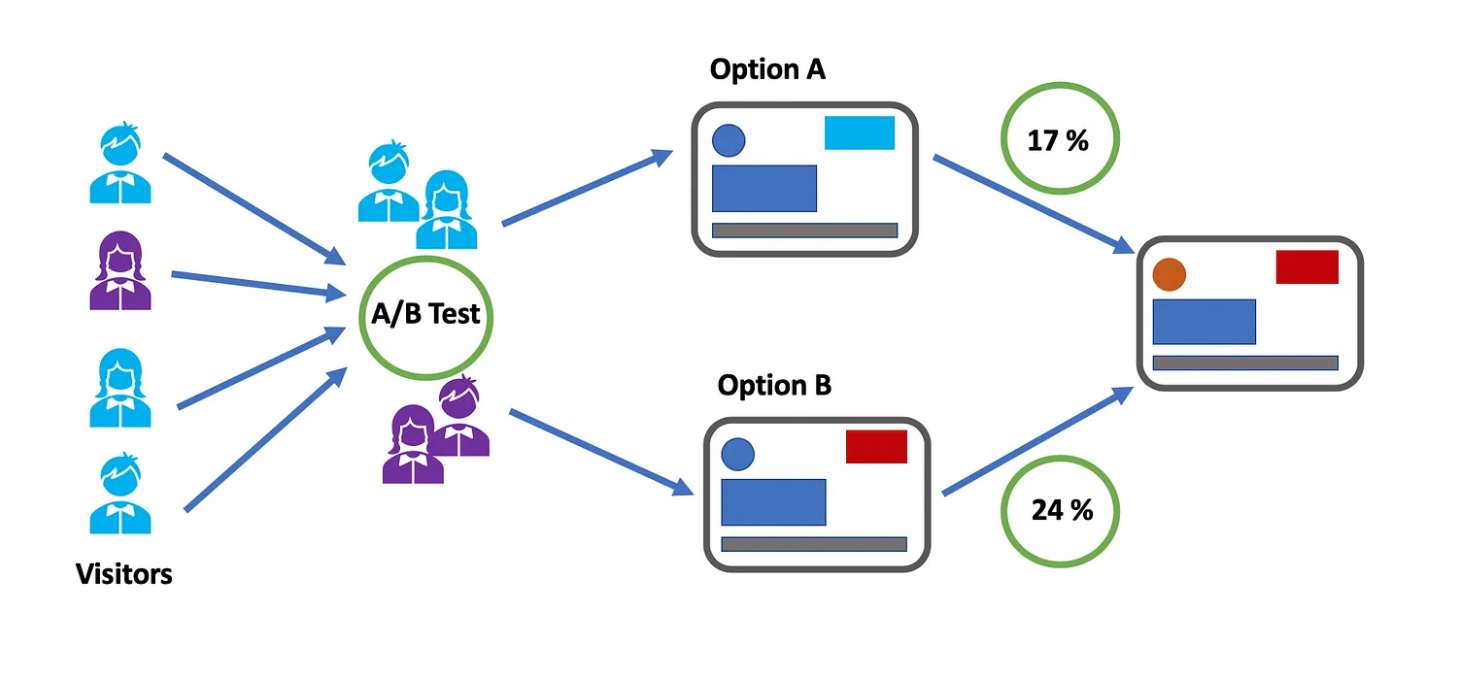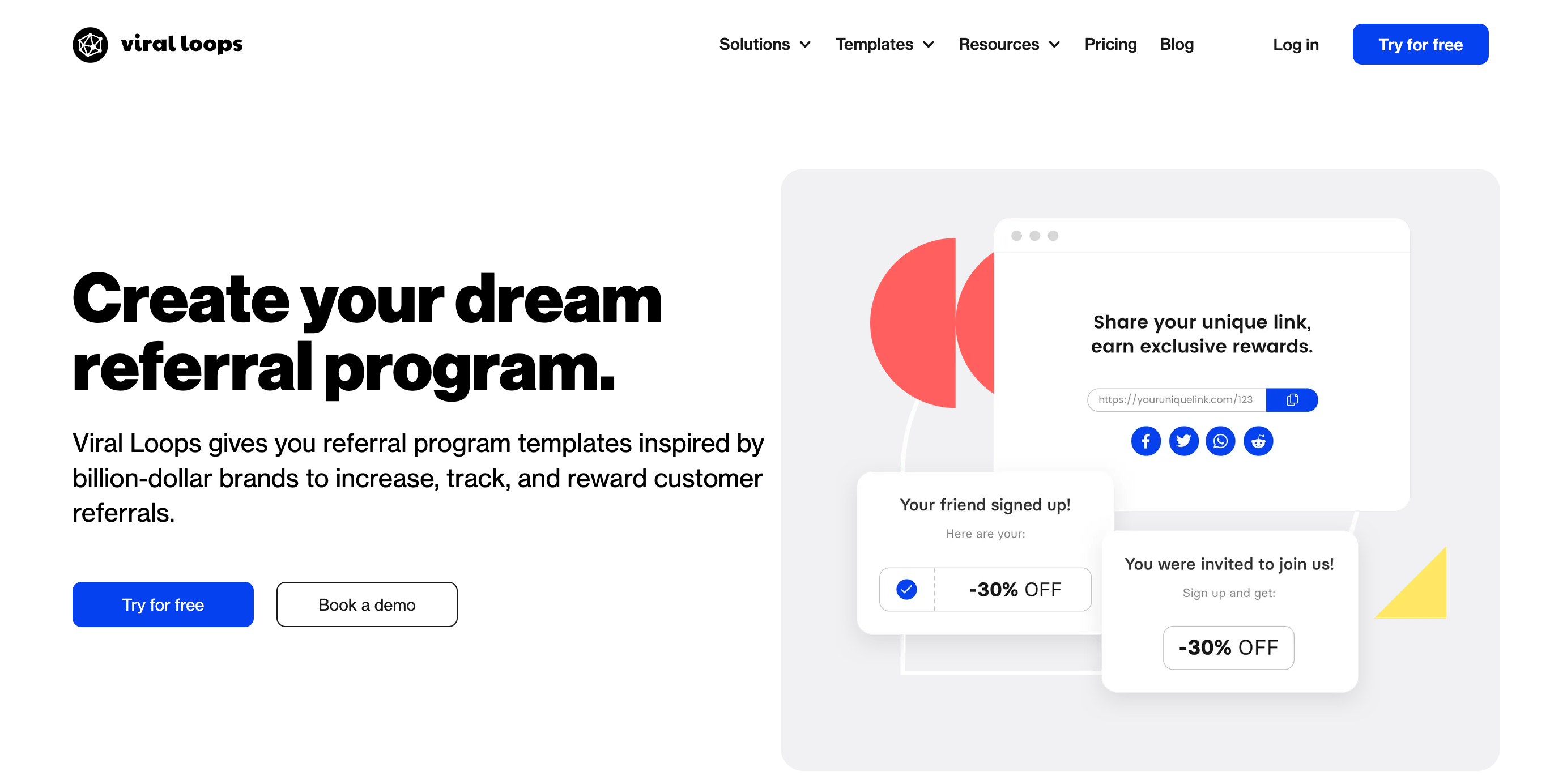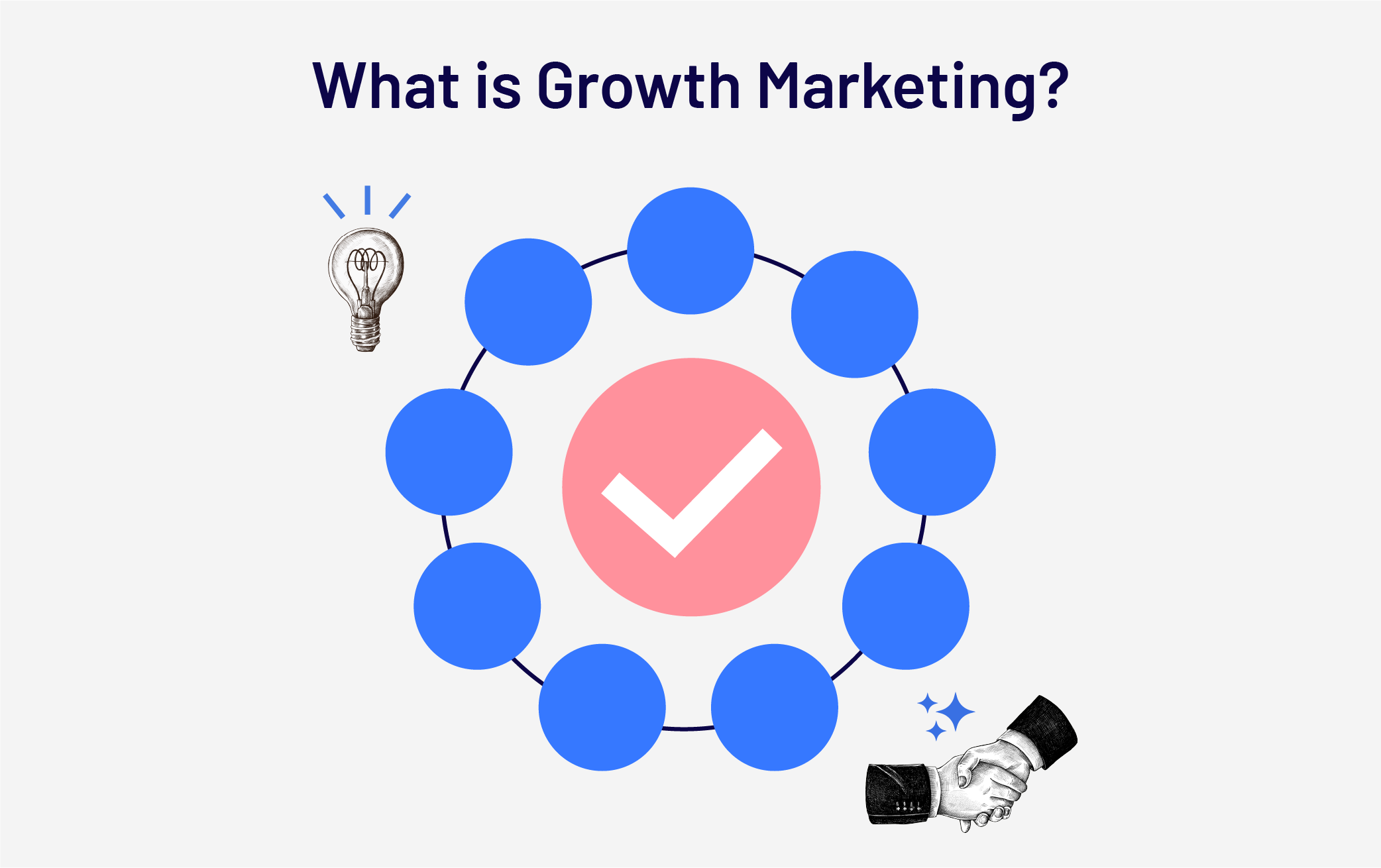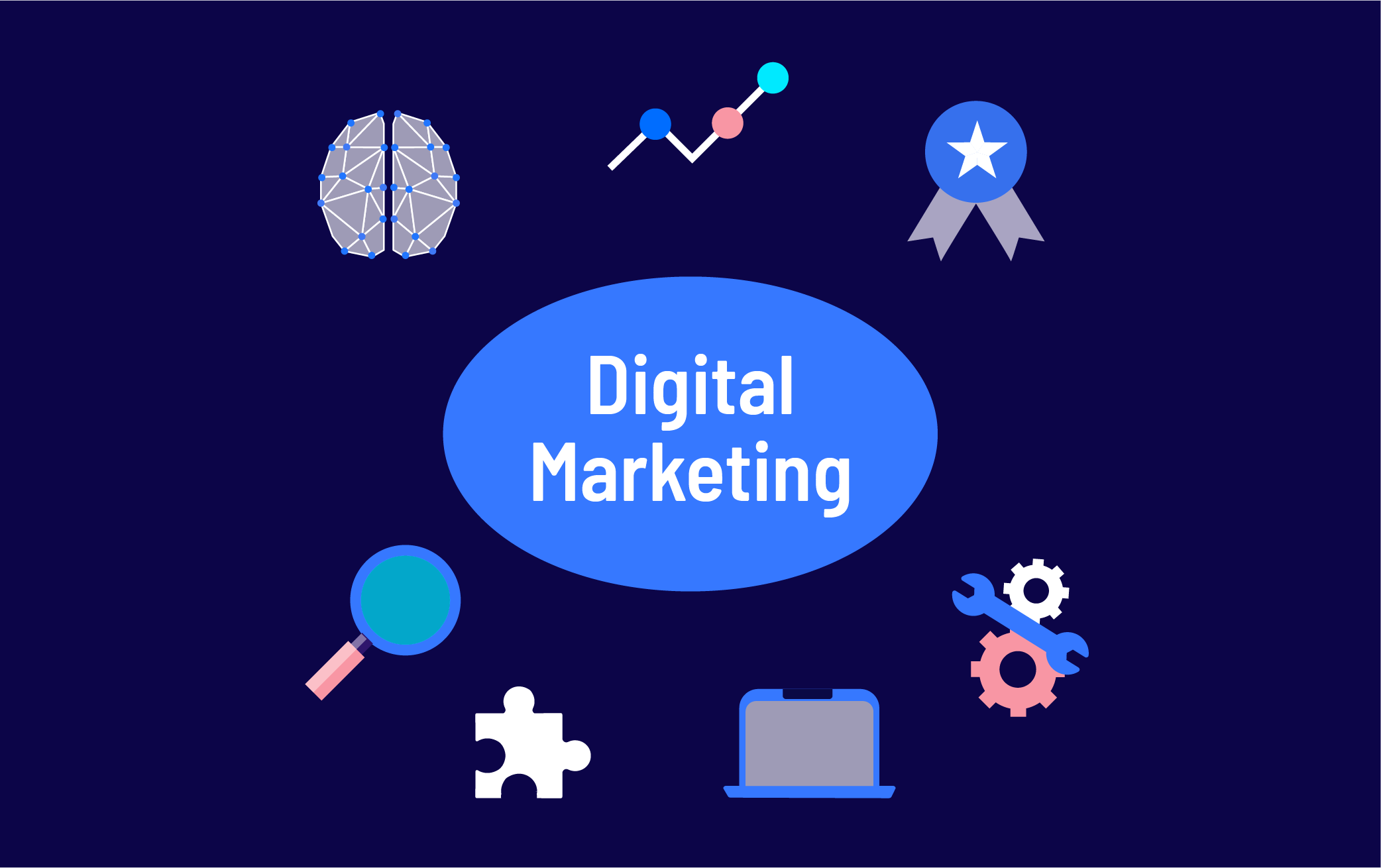Reach your 2024 business targets with these 9 growth strategies
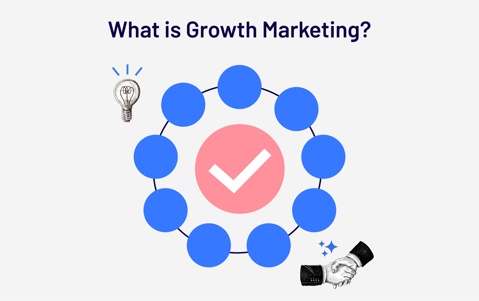
A new approach to marketing has come into place to change how traditional methods work, the so-called growth marketing. With potential customers, long-term strategies, and increasing social media marketing, you must stay up-to-date with marketing tactics to make your business succeed. That's where growth marketing comes into place.
Here we discuss key aspects of the topic, the benefits of growth marketing, examples, and 9 different strategies for 2024 that you could profit from.
So, let's get into that!
We'll be looking into:
- Understanding growth marketing
- The secret sauce to success: growth marketing strategies
- How to build a strong marketing strategy
- 9 Growth marketing strategies
- The GROWS process
- Growth marketing examples
- Conclusion
- FAQ
Understanding growth marketing
Before going deep into the topic, let's first understand what growth marketing actually is.
Traditional marketing has long been the core of promotional efforts, often fixating on short-term, campaign-driven objectives.
Its primary focus tends to be on generating awareness and stirring demand at the top of the marketing funnel for products, services, and brands.
But...this approach typically involves periodic reviews, annually or semi-annually, with gradual adjustments over time.
So, a new paradigm shift towards a more agile methodology has been created: Growth marketing.
Unlike traditional marketing methods, growth marketing focuses on using data and insights to improve business results throughout the entire customer journey.
At its core, growth marketing emphasises the importance of continuous experimentation, monitoring results in real time, and taking a holistic approach to creating a consistent growth strategy for businesses.
It's not just about making small changes here and there: it's about diving deep with multi-channel approaches and innovative tech to unleash amazing results.
So, what exactly distinguishes growth marketing from its traditional counterpart?
Growth marketing is a strategic approach aimed at promoting long-term growth that is sustainable.
Forget about just focusing on brand awareness or lead generation. Instead, let's aim for tangible results like increased revenue, more users, and stronger customer loyalty.
Growth marketers are the architects of constant evolution, eternally exploring from A/B testing to email marketing and SEO mastery, to craft finely-tuned strategies that propel businesses forward.
They continuously seek market insights, always learning, testing, and refining their strategies.
Growth marketers analyse user behaviour and use insights to optimise campaigns for better results.
But the magic of growth marketing doesn't stop there.
This approach goes beyond mere customer acquisition—it goes into the intricacies of customer retention and engagement.
It's about understanding demographics, pain points, and the value propositions that resonate with customer satisfaction.
In the realm of growth marketing, success relies on a comprehensive perspective—one that covers everything from product development to customer experience.
By embracing this panoramic view, businesses can fuel sustained and rapid growth, propelled by an uncompromising commitment to understanding and serving their customers' needs.
(Image source: Growth marketing)
The secret sauce to success: growth marketing strategies
Growth marketers implement different successful growth marketing strategies that make a great impact on revenue, reaching targets and helping with website traffic.
But why is it important to have a strong growth marketing strategy?
Well, in today's dynamic business landscape, implementing effective growth marketing strategies is not just a choice—it's a necessity.
Unlike traditional marketing approaches fixated on fleeting victories, growth marketing sets its sights on long-term expansion, steering businesses towards sustained success.
Here's why you should hop on the growth marketing bandwagon:
-
Accelerated Time-to-Market: Picture this—you have a groundbreaking product or campaign ready to roll out. With growth marketing in your arsenal, you can rapidly launch and repeat based on real-time feedback.
By testing, learning, and refining on the go, you slash the time it takes to get your offerings into the hands of eager customers, giving you a competitive edge in the market. -
Enhanced Return on Investment (ROI): At the end of the day, it's all about the bottom line. Growth marketing isn't just about spending money; it's about investing it wisely.
By leveraging data-driven insights, businesses can identify high-yield opportunities and allocate resources where they'll yield the greatest returns.
The result?
A higher ROI speaks volumes about the effectiveness of your marketing efforts. -
Scalability at its Finest: Imagine a marketing strategy that grows with your business—no overhauls required. That's the beauty of scalability in growth marketing.
A successful campaign isn't just a one-time hit; it's a blueprint for expansion.
Whether you're looking to reach new audiences or conquer new markets, a scalable marketing plan ensures seamless growth without missing a beat. -
Adaptability: In today's fast-paced world, adaptability is a must. Growth marketing champions flexibility, enabling businesses to pivot in response to shifting market dynamics and evolving consumer preferences.
By staying agile and responsive, organisations can stay ahead of the curve and maintain their competitive edge in an ever-changing landscape.
In essence, effective growth marketing strategies aren't just a trend—they're a game-changer.
By embracing a long-term mindset, harnessing the power of data, and staying agile in the face of change, businesses can unlock a world of opportunities and propel themselves towards enduring growth and prosperity.
So why wait?
It's time to harness the power of growth marketing and chart a path towards a brighter, more prosperous future!
If you are interested in doing a course on growth marketing, check out this internationally recognised course to become an expert in the tools.
How to build a strong marketing strategy
Building a strong marketing strategy isn't rocket science, but it does require careful planning and execution.
Here's a straightforward guide to help you navigate the process:
Define Target Audience Personas: Before you embark on any marketing endeavour, it's essential to understand who you're trying to reach.
Take the time to create detailed personas that represent your ideal customers.
What are their demographics, interests, pain points, and aspirations?
By defining your target audience personas, you can tailor your messaging and campaigns to resonate with the right people.
Set Clear Goals and Objectives: Clarity is key when it comes to setting goals and objectives for your marketing strategy.
What do you hope to achieve? Whether it's increasing brand awareness, driving sales, or boosting customer engagement, ensure that your goals are specific, measurable, achievable, relevant, and time-bound (SMART).
Having clear objectives will provide direction and focus for your marketing efforts.
Utilise Data-Driven Insights for Decision-Making: In today's digital age, data is your best friend. Tap into the wealth of information available to you to inform your marketing decisions.
Analyse customer behaviour, track website metrics, and monitor social media engagement to gain valuable insights into what's working and what's not.
By leveraging data-driven insights, you can make informed decisions that maximise your marketing ROI.
Choose the Right Marketing Channels: With several marketing channels available, it's essential to choose the ones that align best with your goals and target audience.
Whether it's social media, email marketing, content marketing, or paid advertising, evaluate each channel's effectiveness in reaching your audience and achieving your objectives.
Don't spread yourself too thin—focus on the channels that offer the highest potential for success.
Develop a Content Strategy: Content is the lifeblood of any successful marketing strategy. Create a content strategy that resonates with your target audience and aligns with your overarching goals.
What type of content will you create? How will you distribute it across different channels?
Whether it's blog posts, videos, infographics, or podcasts, ensure that your content is valuable, relevant, and engaging.
And don't forget to measure the effectiveness of your content strategy to continuously refine and optimise your approach.
9 Growth marketing strategies
Get ready to dive into the world of growth marketing strategies!
We're about to explore nine exciting approaches that have proven to be game-changers for businesses looking to supercharge their growth and success.
Offer freemium or free trial options
Who doesn't love a freebie?
Whether you're into SaaS products or dealing with physical goods, offering freemium or free trial options can significantly impact your growth marketing strategy.
It's a win-win situation—you attract satisfied customers while gathering invaluable feedback to refine your approach down the line.
And if you're offering a service, why not entice potential customers with a free trial?
By removing financial barriers and letting your audience experience the value first-hand, you're paving the way for organic growth and long-term success.
(Image source: Freemium and free trial)
Implement the AAARRR framework
Ever heard of the AAARRR framework, also known as the Pirate Funnel?
It's a special growth marketing tool that helps you tackle key questions at every stage of your customer journey.
Here's how it works: The framework consists of six stages—Awareness, Acquisition, Activation, Revenue, Retention, and Referral.
By diving into these stages, you can uncover valuable insights to inform your growth marketing strategy and create compelling campaigns.
What makes the Pirate Funnel so effective is its ability to provide actionable data at each step of the journey.
Whether you're fine-tuning your content or refining your marketing efforts, this framework gives your growth team the tools they need to set sail towards success.
 (Image source: Pirate funnel)
(Image source: Pirate funnel)
Offer benefits to your most loyal customers
Consider implementing a loyalty programme to keep those loyal customers coming back for more, enhancing their overall experience with your brand.
Imagine this: A returning customer wants to make a purchase, and you surprise them with a special discount not available to first-time visitors.
It's a simple yet effective way to show your appreciation and keep them coming back for more.
But that's not all.
Keep those frequent buyers feeling valued by showering them with gifts, member-exclusive discount coupons, and other loyalty perks.
And for those looking for even more savings, consider offering a paid membership programme with significant discounts—it's a proven strategy for building a fiercely loyal customer base.
(Image source: Loyal customers)
Publish SEO-optimised blog posts
SEO has long been a cornerstone of growth strategies, centred on enhancing online visibility and securing prime spots in search engine results pages (SERPs).
To master SEO, you need to delve into the intricacies of search engine algorithms and ranking criteria.
But perhaps the key to SEO success lies in keyword research—a crucial step in crafting a robust strategy for generating leads.
Once you've got your SEO game down pat, leverage your blog content to drive traffic directly to your product or service pages.
It's a strategic move that can significantly boost lead conversion rates and propel your business towards success.

Helpful Chatbots and AI Assistants
Embracing chatbots and AI assistants is a smart move for offering constant customer support and improving user experience.
These automated helpers don't just answer questions—they're there for your customers 24/7.
By adding chatbots to your website, social media, and messaging platforms, you can:
-
Provide Instant Help: Customers get quick answers around the clock, ensuring they're never left hanging.
-
Access Info Fast: Chatbots dig into your knowledge base to bring product details, prices, and support resources in no time.
-
Offer Personalised Advice: AI-powered assistants suggest products or content based on each customer's preferences and past interactions.
Take your customer service to the next level and ensure those happy customers never disappear by fully embracing chatbots and AI-driven support!
 (Image source: Chatbots)
(Image source: Chatbots)Influencer Partnerships
Looking to broaden your brand's horizons? Collaborating with industry influencers and thought leaders could be the key.
Here's the lowdown:
-
Find Your Match: Seek out influencers who vibe with your brand's values and connect with your target audience.
-
Buddy Up: Reach out and pitch your collaboration ideas—whether it's co-creating content or hosting joint events, there's plenty of room for creative partnerships.
-
Keep It Real: Let influencers tell your brand story in their own authentic way. Authenticity is key to building trust and resonating with their audience.
-
Measure What Matters: Track the impact of your influencer partnerships. Keep an eye on metrics like brand awareness and engagement to see if your collaborations are hitting the mark.
With influencers by your side, you'll not only expand your brand's reach but also add a fresh perspective to your marketing efforts.
And, the platform CreatorIQ can help you find content marketers to craft some appealing content for you within a gasp!
So, what are you waiting for? It's time to team up and make some magic happen!
(Image source: Influencer partnerships)
Email Marketing Automation
In 2024, email marketing automation will remain a trusty tool for building connections with your audience.
By using automation, you can send targeted, timely, and personalised messages to your subscribers, offering numerous benefits.
For starters, automation helps you boost personalisation. By segmenting your email list, you can create tailored content for different groups of subscribers, which can increase engagement and conversions.
Automation also saves time. By setting up automated email workflows, you can schedule emails to be sent at the best times for your subscribers, ensuring they receive content when they're most likely to engage.
Behaviour-triggered messages are another perk of automation. You can send emails based on specific actions or behaviours from your subscribers, such as welcoming new subscribers or reminding them about unfinished purchases.
Consistent communication is important, and automation ensures your audience receives regular, relevant content, regardless of your team's availability.
So, automation tools provide valuable insights into your email campaigns.
By tracking metrics like open rates and conversions, you can learn more about what works and what doesn't, helping you refine your strategies for better results.

A/B testing
Ever heard of A/B testing? It's like a marketing experiment where you compare two different things—like emails, webpages, or ads—to see which one works better.
It's a neat way to figure out what your audience prefers and improve your conversion rate optimization (CRO).
Let's dive into it: You've got a website and you're eager to see which headline (A or B) will attract more sign-ups for your newsletter.
With it, you can continue to experiment to optimise your strategy even further, and the learning journey never stops!
So, how do you find out? You show half your visitors version A with one headline, and the other half get version B with a different one.
Then, you track which one gets more sign-ups. The winner emerges victorious, and that's the one you stick with.
It's all about ongoing experimentation to refine your approach and keep your audience engaged.
Viral loops
A viral loop is a mechanism that drives continuous referrals for exponential growth.
Encouraging your existing customers to promote your brand can create a ripple effect, with each new customer they bring in contributing to further interest and potential growth.
Viral loops are effective marketing strategies due to their simplicity and ability to expand brand reach through referrals without additional costs.
Trust is important for viral loops to be successful. Studies indicate that individuals place more trust in recommendations from their peers than in direct messaging from businesses.
Viral loops leverage this trust, simplifying the process of sharing your brand.
It's like turning your customers into a team of sales representatives.
Curious to learn more?
Viral Loops offers templates for referral programs based on successful brands to help you increase, track, and reward customer referrals, allowing you to create your ideal referral program.
The GROWS process
Ever wondered how to fuel the flames of growth in your marketing strategy?
Enter the G.R.O.W.S. process—a 5-step loop designed to power your marketing experiments and drive success in your growth marketing approach.
This model isn't just another fancy framework—it's a tried-and-tested method employed by growth marketing teams and savvy growth hackers alike.
The 5 steps of the G.R.O.W.S. process are:
- Gather ideas
- Rank Ideas
- Outline experiments
- Work, work, work
- Study data
If you're curious to learn more about how this powerful framework can revolutionise your approach to growth marketing, check out our in-depth article here.
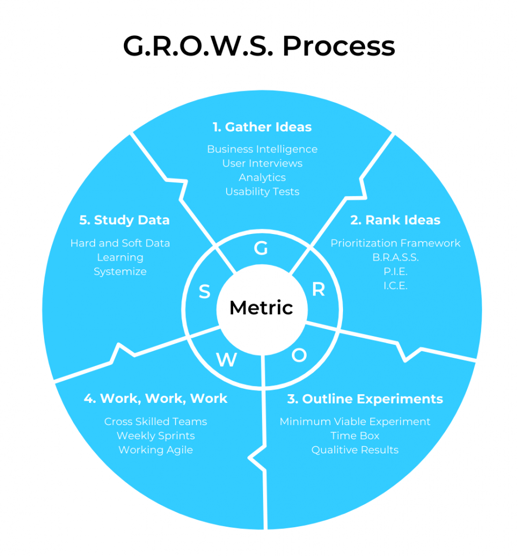
Growth marketing examples
Here are some interesting examples of growth marketing for you to check it out!
Airbnb
Airbnb has become synonymous with affordable accommodation worldwide.
But back in the day, they had to roll up their sleeves and build their user base and reputation from scratch.
The savvy founders spotted an opportunity. They noticed that many potential guests were searching for alternative accommodation on Craigslist.
So, they came up with a genius solution: allowing Airbnb hosts to easily copy their listings to Craigslist with just one click.
This move gave them instant access to a vast pool of potential users.
And the rest, as they say, is history.
Airbnb's smart strategy helped it rapidly grow its customer base and solidify its reputation as the go-to platform for affordable and unique accommodation options.

Dropbox
Dropbox is no stranger to ingenious growth strategies, earning its spot in our collection of top-notch growth hacks.
They took a playful approach to onboarding, turning it into a game for active users.
By incentivising actions like linking their Dropbox accounts to social media and sharing about Dropbox, they attracted new users without spending a penny.
You don't have to be a marketing expert to see the benefits of gamification.
With tools like OptinMonster, boosting your sales and conversions by 40% or more is within reach.
By adding rewards for simple tasks like file sharing, Dropbox encouraged usage and retention.
The result? A staggering 500 million active users and counting.
Proof that sometimes, a little creativity goes a long way in driving exponential growth.

Netflix
Netflix's journey from a humble DVD rental service to the powerhouse of online video streaming is a great example of transformative growth marketing.
Co-founder Reed Hastings had his sights set on conquering the online streaming domain right from the start—hence the name Netflix.
Their trick was giving viewers the freedom to watch whatever they wanted, whenever they wanted—a formula that remains at the heart of their success.
One clever move? Splitting their operations into two: DVDs and online streaming.
They used profits from one to fuel the expansion of the other—a strategy that paid off handsomely.
But that's not all. Netflix didn't stop there.
They snapped up popular TV shows to entice audiences, leveraged social media to engage entertainment enthusiasts and recruited top talent to generate compelling and valuable content that kept subscribers hooked.
This resulted in a staggering 117 million streaming subscribers and counting.
Proof that with a dash of innovation and a sprinkle of determination, even the sky isn't the limit.
(Image source: Netflix)
Conclusion
Growth marketing stands as a dynamic and indispensable approach in today's ever-evolving business landscape.
By delving into the intricacies of growth marketing strategies, we've unravelled the secrets behind successful brand expansion.
From understanding the fundamentals of growth marketing to creating a robust marketing strategy, and exploring nine essential growth tactics, we've navigated through the key components of driving sustainable business growth.
The GROWS process and real-life examples have shed light on the practical implementation of growth marketing principles.
As businesses embrace this innovative methodology and continuously experiment with new ideas, they pave the way for unprecedented growth and success.
By understanding growth marketing principles and strategies and fostering a culture of innovation and collaboration, businesses can navigate the competitive market landscape and achieve long-term success.
FAQ
What are growth marketing strategies?
Growth marketing strategies are tactics and techniques used by businesses to acquire and retain customers, with a primary focus on driving sustainable growth.
Why are growth marketing strategies important for businesses?
These strategies are important for businesses as they are an opportunity for growth, increase revenue, and ultimately achieve long-term success.
How do growth marketing strategies differ from traditional marketing approaches?
Traditional marketing approaches usually rely on mass advertising and branding efforts, while growth marketing strategies involve continuous testing and optimisation to achieve specific growth goals.
What are some key components of effective growth marketing strategies?
Key components of effective growth marketing strategies include identifying target audiences, creating personalised messaging, optimising channels for acquisition, retention, and referral, analysing data to inform decision-making, and continuously adapting strategies based on performance.
How can businesses implement growth marketing strategies?
Businesses can implement growth marketing strategies by defining goals, researching customer needs, tracking metrics with data analytics, experimenting through A/B testing, investing in growth tools, and fostering an innovative team culture.
Categories
- Business & Innovation (72)
- Growth & Marketing (58)
- Data & Analytics (27)
- UX Design (13)
- Alumni Stories (11)
Related articles
Latest articles
Boost your Revenue Growth using LinkedIn Social Selling
In a digital age where connections mean everything, leveraging...
The Power of Collaboration: Enhancing Team Performance Tactics
As organisations navigate complex challenges and strive for...
The Ultimate guide to boost organic growth in 2024
Imagine organic growth as the business equivalent of sculpting...
The best 2024 Business Development Guide
What exactly is business development, and how does it differ from...




